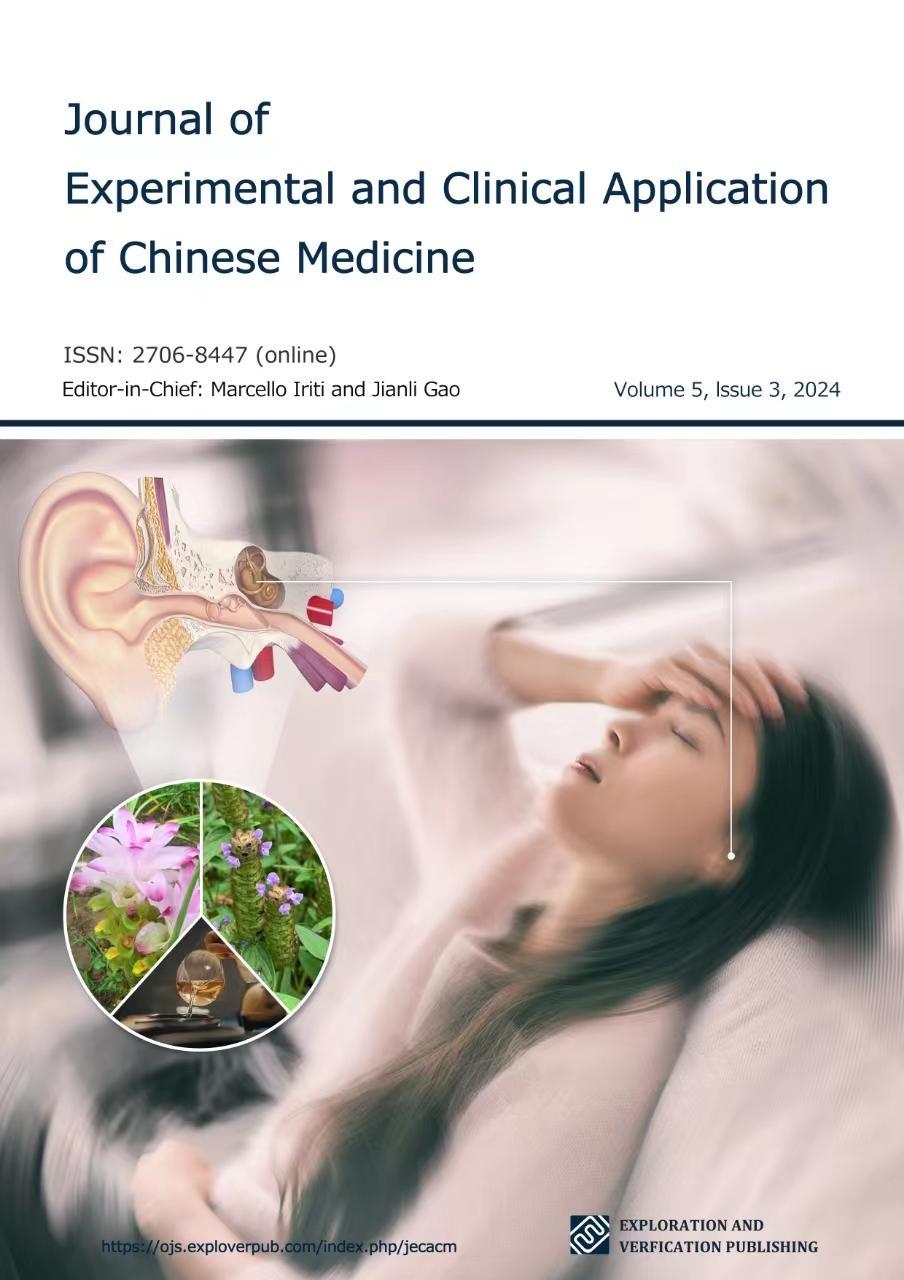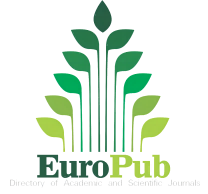Rhizoma Zedoariae Inhibits G-CSF-Induced MDSCs-like Differentiation of THP-1 Cells
DOI:
https://doi.org/10.62767/jecacm503.1126Abstract
Objective: Rhizoma Zedoariae is widely used in the treatment of solid tumors in China, but there has been no deep research on its role in the formation of timmunosuppressive environments mediated by myeloid-derived suppressor cells (MDSCs) in breast cancer. This research aims to investigate the effect of Rhizoma Zedoariae extract and its active compounds curcumin and germacrone on MDSCs-like differentiation by a novel Granulocyte colony-stimulating factor (G-CSF) induced THP-1 cell model. Methods: THP-1 cells were treated with Rhizoma Zedoariae extract and its active compounds (curcumin, germacrone, curcumol, curcumenol, and curdione) at different concentrations (0.01, 0.1, 0.3, 1, 10, 30, 100, and 300 μg/mL), followed by 3-(4,5-dimethylthiazol-2-yl)-2,5-diphenyltetrazolium bromide (MTT) assay to detect the changes of cell viability in THP-1. Quantitative real-time reverse transcription polymerase chain reaction (qRT-PCR) was performed to quantify the mRNA expression levels of transforming growth factor-β (TGF-β), Interleukin-10 (IL-10), Interleukin-6 (IL-6), Janus kinase 1 (JAK1), nuclear factor kappa-B (NF-κB), signal transducer and activator of transcription 3 (STAT3) and arginase-1 (ARG-1), to detected the differentiation of THP-1 into MDSCs-like cells. Results: G-CSF can induce the cell viability and MDSCs-like differentiation of THP-1 cells. Rhizoma Zedoariae extract (0.1, 1, 10, 30, 100, 300 μg/mL), germacrone (0.1, 1, 10, 30, 100, 300 μg/mL) and curcumin (0.01, 0.1, 1, 10, 30, 100 μg/mL) exerted obvious inhibitory effects (>70%) on THP-1 cell viability. G-CSF increased the ARG-1 and IL-10 mRNA levels. Rhizoma Zedoariae extract in 100 μg/mL decreased the ARG-1 and IL-10 mRNA levels. Furthermore, Rhizoma Zedoariae extract in 300 μg/mL also significantly decreased the mRNA expressions of JAK1 and STAT3 (p < 0.001). Conclusion: Rhizoma Zedoariae extract maybe inhibit G-CSF-induced MDSCs-like differentiation of THP-1 through the STAT3 pathway. The active compound that exerts this effect may be germacrone and curcumin.
References
Siegel RL, Miller KD, Wagle NS, et al. Cancer statistics, 2023. CA: A Cancer Journal for Clinicians 2023; 73(1): 1-32.
Badwe R, Hawaldar R, Nair N, et al. Locoregional treatment versus no treatment of the primary tumour in metastatic breast cancer: an open-label randomised controlled trial. The Lancet Oncology 2015; 16(13): 1380-1388.
Yang X, Tu Q, Zheng XQ, et al. Retrospective study of 577 patients with splenomegaly. The Practical Journal of Cancer 2010; 25(6): 632-635.
Shou DW, Wen L, Song ZY, et al. Suppressive role of myeloid-derived suppressor cells (MDSCs) in the microenvironment of breast cancer and targeted immunotherapies. Oncotarget 2016; 7(39): 64505-64511.
Alshetaiwi H, Pervolarakis N, Mcintyre LL, et al. Defining the emergence of myeloid-derived suppressor cells in breast cancer using single-cell transcriptomics. Science Immunology 2019; 5(44): eaay6017.
Xu LL, Li LJ, Zhou W, et al. Research and application prospect of myeloid suppressor cells in tumor therapy. Clinical Focus 2017; 32(06): 545-548.
Samantha S, Laura PT, Vera D, et al. Highlights on molecular mechanisms of MDSC-mediated immune suppression: paving the way for new working hypotheses. Immunological Investigations 2012; 41(6-7): 722-737.
Gonda K, Shibata M, Ohtake T, et al. Myeloid-derived suppressor cells are increased and correlated with type 2 immune responses, malnutrition, inflammation, and poor prognosis in patients with breast cancer. Oncology Letters 2017; 14(2): 1766-1774.
Solito S, Falisi E, Diaz-Montero CM, et al. A human promyelocytic-like population is responsible for the immune suppression mediated by myeloid-derived suppressor cells. Blood 2011, 118(8): 2254-2265.
Serafini P, Borrello IV. Myeloid suppressor cells in cancer: recruitment, phenotype, properties, and mechanisms of immune suppression. Seminars in Cancer Biology 2006; 16(1): 53-65.
Goh C, Narayanan S, Hahn YS. Myeloid-derived suppressor cells: the dark knight or the joker in viral infections? Immunological Reviews 2013; 255(1): 210-211.
Diaz-Montero CM, Finke J, Montero AJ. Myeloid-derived suppressor cells in cancer: therapeutic, predictive, and prognostic implications. Seminars in Oncology 2014; 41(2): 174-184.
Ni WT, Pan YH, Wang AY, et al. Research progress in inhibition of Chinese materia medica with breaking blood stasis and resolving mass on tumor metastasis. Chinese Herbal Medicine 2016; 47(24): 4472-4477.
Li XQ, Lin ZH, Zhang B, et al. β-elemene sensitizes hepatocellular carcinoma cells to oxaliplatin by preventing oxaliplatin-induced degradation of copper transporter 1. Scientific Reports 2016; 6: 21010.
Mao YE, Liu X, He K, et al. Xuanhusuo Powder inhibits myeloid-derived suppressor cells differentiation in the spleen of breast cancer mice by down-regulating G-CSF. Journal of Zhejiang University (Medical Science) 2023; 52(01): 88-100.
He BQ, Guo WQ, Shi RZ, et al. Ruyong Formula improves thymus function of CUMS-stimulated breast cancer mice. Journal of Ethnopharmacology 2023; 319: 117164.
Tang DC, Zang WH, Feng HH. Influences of medicated serum of different cultivars of Ezhu (Rhizoma Zedoariae) on proliferation, apoptosis and nucleo-cytoplasmic ratio in human gastric carcinoma cells BGC823. Journal of Beijing University of Traditional Chinese Medicine 2013; 36(04): 254-257+267+289.
Tang X, Han FJ, Li W, et al. Research on the effect of Curcumol in JAK2/STAT3 signaling pathway in human ovarian cancer cell line SKOV3. Chinese Journal of Clinical Obstetrics and Gynecology 2013; 14(01): 43-46.
Li HH, Ren WL, Xu CW, et al. Study on the effect of curcumin on triple negative breast cancer cells drug sensitivity and exploring the mechanism. Journal of Modern Oncology 2019; 27(23): 4139-4144.
Chiu TL, Su CC. Curcumin inhibits proliferation and migration by increasing the Bax to Bcl-2 ratio and decreasing NF-kappaBp65 expression in breast cancer MDA-MB-231 cells. International Journal of Molecular Medicine 2009; 23(4): 469-475.
Qi XG, Han X, Hao JZ, et al. Mechanism of curcumin inhibiting proliferation and invasion of breast cancer cells. Chinese Journal of Cancer Prevention and Treatment 2018; 25(17): 1211-1216.
Chen QF, Wang G, Li ZF, et al. Research progress of germacrone pharmacological effects. Chinese Archives of Traditional Chinese Medicine 2017; 35(09): 2312-2315.
Liu YY, Zheng Q, Fang B, et al. Germacrone induces apoptosis in human hepatoma HepG2 cells through inhibition of the JAK2/STAT3 signalling pathway. Journal of Huazhong University of Science and Technology - Medical Science 2013; 33(03): 339-345.
Zhong ZF, Chen XP, Tan W, et al. Germacrone inhibits the proliferation of breast cancer cell lines by inducing cell cycle arrest and promoting apoptosis. European Journal of Pharmacology 2011; 667(1-3): 50-55.
Zhang CH, Li ZY, Luo XF, et al. Mechanism of curcumin on injury repair in mice with inflammatory bowel disease induced bydextran sulfate sodium. Heilongjiang Animal Science and Veterinary Medicine 2019; 23: 15-17+168.
Liu LL. Effect of curcuma kwangsiensis S. G. Lee et C. F. Liang on TGF-β1/Smads signaling pathway in mice with hepatic fibrosis induced by blood stasis. Journal of Guangxi University of Chinese Medicine 2019.
Lu Y, Miao L, Wang YH, et al. Curcumin Micelles Remodel Tumor Microenvironment and Enhance Vaccine Activity in an Advanced Melanoma Model. Molecular Therapy 2016; 24(2): 364-374.
Singh M, Ramos I, Asafu-Adjel D, et al. Curcumin improves the therapeutic efficacy of a Listeria(at)-Mage-b vaccine in correlation with improved T-cell responses in blood of a triple-negative breast cancer model 4T1. Cancer Medicine 2013; 2(4): 571-582.
Tu SP, Jin HY, Si JD, et al. Curcumin lnduces the Differentiation of Myeloid-Derived Suppressor Cells and Inhibits Their Interaction with Cancer Cells and Related Tumor Growth. Cancer Prevention Research 2012; 5(2): 205-215.
Liu D. The novel α-glucan and curcumin ameliorate inflammatory diseases through modulating the expansion and immunosuppressive function of MDSCs. Nanjing University: Nanjing, China, 2016.
Xie YJ, Zhang Y, Wei XH, et al. JianpiHuayu Decoction Attenuates the Immunosuppressive Status of H22 Hepatocellular Carcinoma-Bearing Mice: By Targeting Myeloid-Derived Suppressor Cells. Frontiers in Pharmacology 2020; 11: 16.
Giles A, Reid C, Evans J, et al. Activation of hematopoietic stem/progenitor cells promotes immunosuppression within the pre-metastatic niche. Cancer Research 2016; 76(6): 1335-1347.
Atretkhany K, Nosenko M, Gogoleva V, et al. TNF Neutralization Results in the Delay of Transplantable Tumor Growth and Reduced MDSC Accumulation Frontiers in Immunology. Frontiers in Immunology 2016; 7(8): 147-158.
He K, Liu X, Hoffman RD, et al. G-CSF/GM-CSF-induced hematopoietic dysregulation in the progression of solid tumors. FEBS Open Bio 2022; 12(7): 1268-1285.
Pan T, Liu YF, Zhong LM, et al. Myeloid-derived suppressor cells are essential for maintaining feto-maternal immunotolerance via STAT3 signaling in mice. Journal of Leukocyte Biology 2016; 100(3): 499-511.
Yang Q, Li X, Chen H, et al. IRF7 regulates the development of granulocytic myeloid-derived suppressor cells through S100A9 transrepression in cancer. Oncogene 2017; 36(21): 2969-2980.
Zhu RL, Zhi YK, Yi L, et al. Sinomenine regulates CD14/TLR4, JAK2/STAT3 pathway and calcium signal via α7nAChR to inhibit inflammation in LPS-stimulated macrophages. Immunopharmacology and Immunotoxicology 2019; 41(1): 172-177.
Cocchiola R, Rubini E, Altieri F, et al. STAT3 post-translational modifications drive cellular signaling pathways in prostate cancer cells. International Journal of Molecular Sciences 2019; 20(8): E1815.
Hua Y, Marcin K, Drew P. Crosstalk between cancer and immune cells: role of STAT3 in the tumour microenvironment. Nature Reviews Immunology 2007; 7(1): 41-51.
Published
Issue
Section
License
Copyright (c) 2024 The Author(s)

This work is licensed under a Creative Commons Attribution 4.0 International License.







